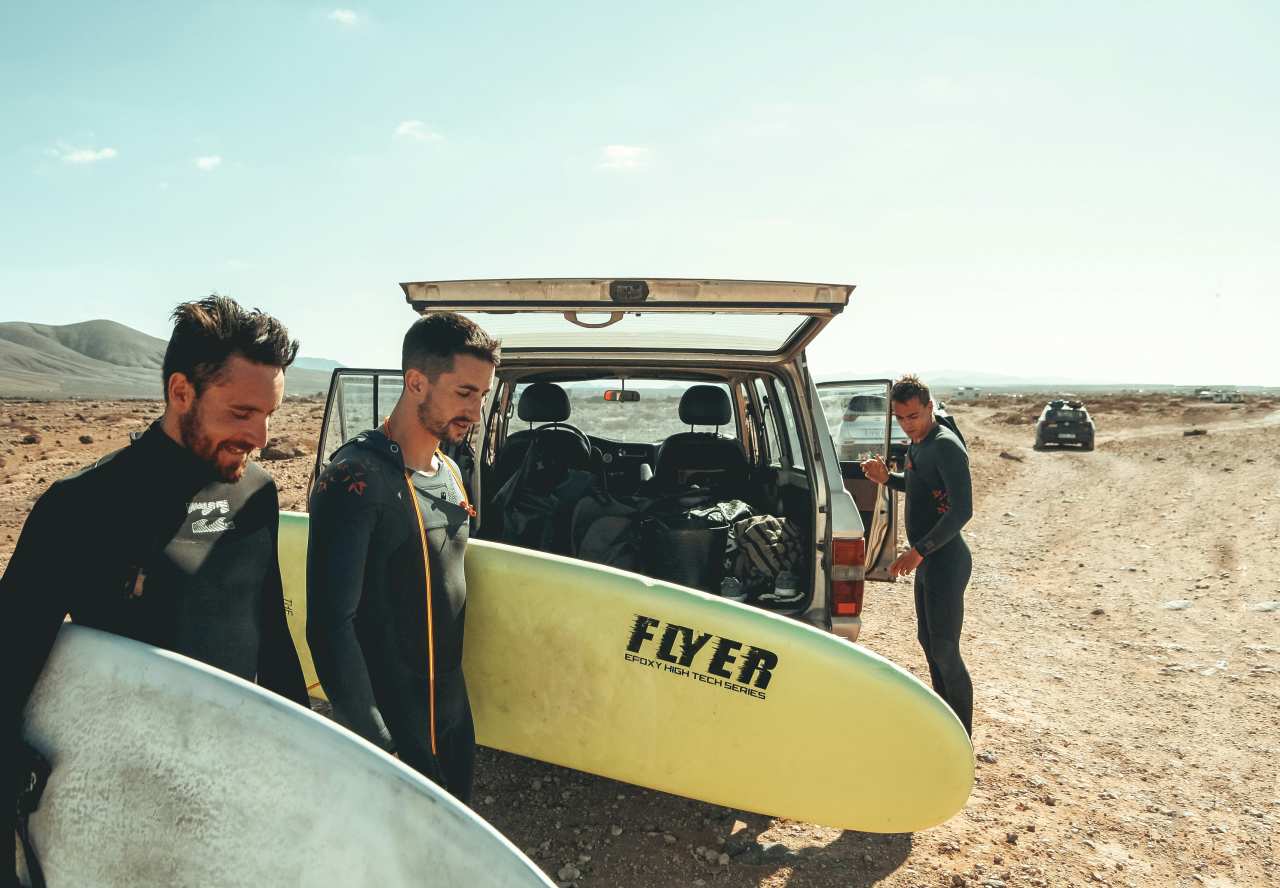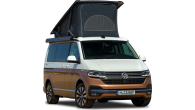While a global pandemic was busy wreaking havoc on the international travel industry, Australians overwhelmingly turned inward to the realm of 4x4s, camper trailers, and campervans to explore the corners of our massive continent.
It’s a trend which has existed here long before the pandemic, though, with local outfits like Trakka already cashing in on the momentum of modified vans to suit all sorts of long-distance tourers, old and new.
It is a ripe time then, for Volkswagen’s own first-party camper creations, to enter the Australian market, as the latest versions of the Caddy, Multivan, and Transporter.
In such a competitive space, though, are there good reasons to consider the Transporter-based California over its home-grown rivals from the likes of Trakka? Let’s take a look.
Volkswagen California 2023: Tdi340 California Beach
| Engine Type | Diesel Turbo 4, 2.0L |
|---|---|
| Fuel Type | Diesel |
| Fuel Efficiency | 6.6L/100km (combined) |
| Seating | 7 |
| Price From | $85,250 - $98,010 |
Does it represent good value for the price? What features does it come with?
The exact van we’re looking at for this review is the Volkswagen California Beach TDI340 4Motion.
This means it’s the middle of three variants in the California Beach range, which kicks off from $90,990, before on-road costs, for the base front-wheel drive, $94,990 for this all-wheel drive version we’re testing, or $100,990 for the more powerful TDI450 version.
Our mid-spec also had a long list of attached options, including the Kombi-style two-tone paint ($4050), upgraded interior package which includes microfleece seat trim, heated front seats, and the improved digital dash suite ($3690), an electric pop-up roof ($3050), LED headlights ($2050), adaptive chassis control ($2010), the 'Off-Road Pack' (includes a rear diff lock and downhill assist - $1720), power sliding doors (both sides, $1640), fog lights with cornering function ($770), 'Park Assist' ($460), 'Light Assist' ($320), and the no-cost option of a silver-coloured awning.
.jpg)
The list of extras (valued at a total of $19,760) brought the price as-tested (and still before on-roads) to a substantial $114,750.
In concept then we’re left with a van which has pretty much all the creature comforts of a Volkswagen passenger car with two beds (one in the pop-up roof, the other consisting of the fold-out rear seats).
In isolation, this may seem reasonable for such a custom camping solution, but the issue arrives when you consider competitors.
.jpg)
Trakka’s most direct rival, the Trakkadu, can be had from $137,422 and offers such luxuries not even optionally available on the California Beach, like an improved power system (to support 240V outlets), a kitchenette, fridge, plenty of additional storage, and a water supply.
Your $94,990 California Beach in base form then is essentially a Multivan with an awning, interior shades and lighting, a rear fold-out bed and bench, and a set of two chairs and a table.
While it’s very nice to have custom fit blinds on every window and fully adjustable built-in interior lighting, you’ll then need to go and spend more on a power system and possibly plumbing if you want it to be a truly luxurious long-distance tourer. It’s too bad we miss out on higher-spec vehicles available overseas.
.jpg)
Is there anything interesting about its design?
The California Beach does offer an iconic slice of VW’s historic Kombi aesthetic, modernised to its current range. While the two-tone paint is a remarkably expensive option, it does seal the #vanlife deal.
Two-tone paint or not, though, you could do much worse in terms of aesthetics than the Transporter 6.1, which is about as graceful as commercial vehicles come with its now-giant chrome embossed grille, matching painted bodywork, appealing little alloy wheels, and with the LED light package fitted, a contemporary shine profile at night.
The California Beach also hides its status as a camper well, blending in with other people movers and commercial vehicles in traffic with the slight hint given away by its branding and the awning hanging off one side.
.jpg)
The pop-up tent option in our test car is invisible from the outside, and with the seats in their default position, it could be any passenger-oriented van on the road.
More on that later, but the interior, too, brings much of the comfort and aesthetic from the rest of VW’s passenger car range.
Those who want to use this as a multi-role vehicle when they’re not camping will be pleased by its up-to-date interior appointments, with the pragmatic but attractive leather-bound VW wheel shared with other current products, as well as the option of the ever-impressive ‘Digital Cockpit’ dash.
.jpg)
The seats are aesthetically pleasing, with the only giveaway this is a commercial vehicle being the hard plastics with a more rugged pattern across the dash and doors in place of the usual soft materials which adorn Volkswagen passenger cars.
As subtle and sensible as the California may be though, there was no doubt it was instantly recognised at the campground, with owners of other Transporters, Trakkas, and other campervans coming to have a look at a model they clearly knew of.
How practical is the space inside?
Interior space in this camper is one of its key highlights. As a van it has a huge and versatile cargo area behind the front seats, with the fold-down rear row on rails to maximise cargo capacity if need be.
A rear shelf at the back can be used for all your storage needs, with a compact space underneath for securing everything from camping equipment to shopping bags on the day-to-day and there are even little draws underneath the sliding seat row for the storage of small items (it was handy to use these for the awning’s winder and pegs, the luggage net which we weren’t using, and other things you don’t want to lose.
VW doesn’t quote a VDA number for the total luggage space given how versatile the load area is, although it does state there is 4.3 square metres of space in the cabin.
.jpg)
As already mentioned, the key advantage of this camper over others is its ease of use. Setting it up and packing it down is a 10 minute affair, allowing you the flexibility to be ready to camp or explore the local area in a pinch.
The California we tested sits five and even has ISOFIX mounts on the outer rear seats, but for larger families, there’s also a seven-seat option, with the extra seats folding down to make for a larger bedding area.
The awning itself is manually operated with a winder and pop-out legs. The front two seats are ‘captain’s chairs’ which can rotate 180-degrees to face back into the cabin.
.jpg)
It’s a neat and sometimes necessary addition to allow for a seating area if the bed is deployed, but they are a little fiddly to operate.
To swivel them, you need to fully fold the steering column away, move the seat all the way forward, rotate it half way, then move it forward again to clear the wheel in the driver’s position.
Practicality for the driver and front passenger while on the move is excellent, with two sets of huge cutaways in the doors for the storage of objects, cupholders seated atop the dash, a big bay for books or laptops which also houses a 12V outlet, and there are adjustable-height armrests attached to the seats.
.jpg)
The seats and wheel are also very adjustable, and the roof is high allowing plenty of space for people of all heights.
A small issue I ran into was the awkward lack of a place to put my phone. The most obvious location seemed to be the cupholder next to the shift lever, especially since this is where the USB-C connections were located, although it was a bit awkward, and my phone and wallet would easily fall out onto the floor, from where they could simply disappear into the rear of the cabin under acceleration.
What are the key stats for the engine and transmission?
The version of the California Beach we tested for this review was the mid-grade TDI340 4Motion.
This means it is powered by a 2.0-litre, four-cylinder, turbo-diesel engine producing 110kW/340Nm. It’s paired with a seven-speed dual-clutch automatic, and in the case of this model, is capable of driving all four wheels.
It’s not much for power, but with the large amount of torque available, pulls strongly even when loaded up.
.jpg)
While it’s nice to have the all-wheel drive for loose surfaces and the like, clearance is limited so I wouldn’t venture into the rough stuff, even with the optional differential lock.
For those looking to fit further enhancements, or tow, the California Beach’s GVM is 3080kg leaving 623kg for payload, and it can tow 750kg unbraked or 2500kg braked.
What's it like as a daily driver?
One of the California's more appealing features is the way its camping features can be minimised. Unlike some fit-outs which feature built-in fittings, once you pack the rear bed away and fold everything up, it makes for an appealing five-seat van for driving around in day-to-day traffic.
The diesel engine offers a rugged soundscape but plenty of pulling power once you overcome a moment of turbo-lag for cargo, people and equipment, and visibility is great out the front and sides.
The dual clutch transmission behaved well in my time with the van, although like many cars which use this transmission it can occasionally cost you a second at an intersection as it combines with the stop-start system to make for a moment of delay.
_0.jpg)
The California is a relatively easy van to park and live with when you’re not out on the road, and features a nice organic steering tune to give you plenty of confidence in the corners, bolstered by the addition of all-wheel drive in the van we tested.
The ride when empty is quite rough, like many vans in this segment. With the diesel engine, this can make for a bit of a noisy experience on coarse-chip freeways, and especially gravel roads. Potholes can also be cringe-inducing.
As always one of the biggest advantages of VW commercial products is how closely they can be specified to VW’s passenger vehicles.
.jpg)
With the right option boxes ticked, for example, our car had the very welcome digital dash, and the multimedia suite.
While not the latest fully touch unit you can experience in cars like the Golf 8, it has the welcome addition of tactile shortcut buttons and dials for ease-of-use while driving.
With the fold-away roof, the California also isn’t bigger than a regular Transporter van. At 1990mm high it should fit in most parking lots and garages.
What's it like for touring?
It’s nice this van can be packed up from an able camper into a relatively comfy touring van in just 10 or so minutes, and it makes for a camper which can be your exploring vehicle and your home at the campground.
Certainly, this was something our fellow campers were envious of, with their trailers sometimes taking hours to set up, not to mention the unpleasantness of needing to deal with wind and rain in a tent.
The bed folds out easily, and the lower mattress offers decent levels of comfort, although I would recommend a mattress topper for best results.
The rooftop tent has a thinner but ultimately more comfortable mattress as it also features some innovative plastic springs for it to rest on, which were surprisingly supportive.
.jpg)
You’d need to be quite fit and active to be able to climb up into it, however. Older buyers may prefer to use the bed in the cabin.
The California’s other party trick is that all the windows have blinds on them so you can almost black out the cabin and allow for campground privacy when it’s time to sleep (although there are a few notable light leaks for the blinds which cover the windscreen).
Cleverly, the little fold-out table snaps into a cavity in the driver’s side sliding door, and the two chairs slide into the tailgate for secure storage without taking up any additional space in the cabin.
The ambient lighting zones on the interior can be fully controlled and are dimmable via a touchscreen in the roof, and this panel can also be used to operate the motorised roof and monitor the available power in the second battery (which is located under the front passenger seat)
.jpg)
What I found most limiting about the set-up was the lack of a heavy-duty inverter for better power, meaning it’s hard to charge devices, power things like fridges, or bring along household conveniences like electric blankets.
Sure, you can buy 12V versions of these things, but they’re naturally compromised, and it’s annoying that you have to after spending nearly $100,000 on a ready-to-go camper.
The lack of a kitchen, even as an option, necessitates the bringing of a gas barbeque if you want to venture beyond campgrounds which have a healthy set of amenities, as does the lack of any kind of water storage.
Evidently, this van is ripe for further augmentation and modification, and there are several outfits (like VanEssa) which can upgrade it to have kitchenettes, extra storage, and other conveniences which are missing from the factory package.
.jpg)
A notable addition is the ability to have the California keep the cabin warm when the ignition is off using its auxiliary battery, which is a necessary addition for winter adventures.
While the all-wheel drive available on our test car is welcome, the van itself is quite low to the ground and has limited angles, so while it will be fine on gravel surfaces, I wouldn’t recommend venturing too far beyond well-graded tracks.
For those wanting to get a bit more adventurous, Trakka offers a more off-road oriented package in its competing Trakkadu set-up (albeit at a significantly higher cost).
So, is the California Beach as easy-going as it seems? Yes. But it’s perhaps a bit too easy-going, as for longer-term touring beyond a weekend or two it still requires significant additions.
How much fuel does it consume?
The California Beach TDI340 4Motion has an official combined fuel consumption figure of 7.5L/100km and a relatively large 80-litre fuel tank, allowing for a healthy cruising range for those more distant camping locations.
Our camping journey (a roughly 600km return trip) meant the California travelled mostly freeway kilometres on our week with the car, and it produced an overall figure of 7.4L/100km. It takes diesel and also has a 13-litre AdBlue tank.
.jpg)
Warranty & Safety Rating
What safety equipment is fitted? What safety rating?
The California has a decent set of standard safety inclusions, like city-speed auto emergency braking (it’s important to note this is not the usual freeway-speed system which ships on most VW passenger cars), blind spot monitoring with rear cross traffic alert, driver attention alert, and adaptive cruise control.
It doesn’t have lane support systems, but does additionally score tyre pressure monitoring (good for those gravel trails), front and rear parking sensors and a decent rear view camera, hill start assist, and even crosswind assist.
.jpg)
In terms of more passive safety items it scores only driver and passenger front and side airbags, something to keep in mind when transporting passengers in the rear.
For touring it’s hard not to recommend the optional LED headlights for those poorly-lit and far-flung roads, and thankfully the California comes with a full-size steel spare should you end up with a flat in the middle of nowhere.
For a commercial-based vehicle the safety suite is not bad, but when compared to a passenger vehicle, it could do better.
What does it cost to own? What warranty is offered?
The California Beach is covered by a five year and unlimited kilometre warranty like the rest of the Volkswagen passenger car range, which includes one year of roadside assistance.
The prime advantage of buying a first-party Volkswagen camper is the entire vehicle is covered by this warranty, as opposed to needing to deal with two warranties if you were to buy from a brand like Trakka.
.jpg)
There is also the option of a five or three year service plan. At the time of writing, the five year service plan was running at the price of a three year plan, valued at $1850 for this 4Motion variant, or just $370 a year for the life of the warranty.
This is a claimed saving of $2302 over the cost of regular scheduled maintenance. Visits to the workshop are required once every 12 months or 15,000km, whichever comes first.
Verdict
A van like this is the envy of campgrounds, and with a fully warranted set of cosy extras, it’s ready to roll from day one, too.
As a weekender the California Beach is ideal, and one of its most appealing attributes is how easily it can also be packed up and used for day-to-day duties when you’re not out adventuring on the road.
Keep in mind for longer term touring you’ll need a fair bit of extra kit to make this California as capable as some rivals, and there’s always Trakka waiting for you if you want to spend more coin.






.jpg)

.jpg)
.jpg)



.jpg)
.jpg)



